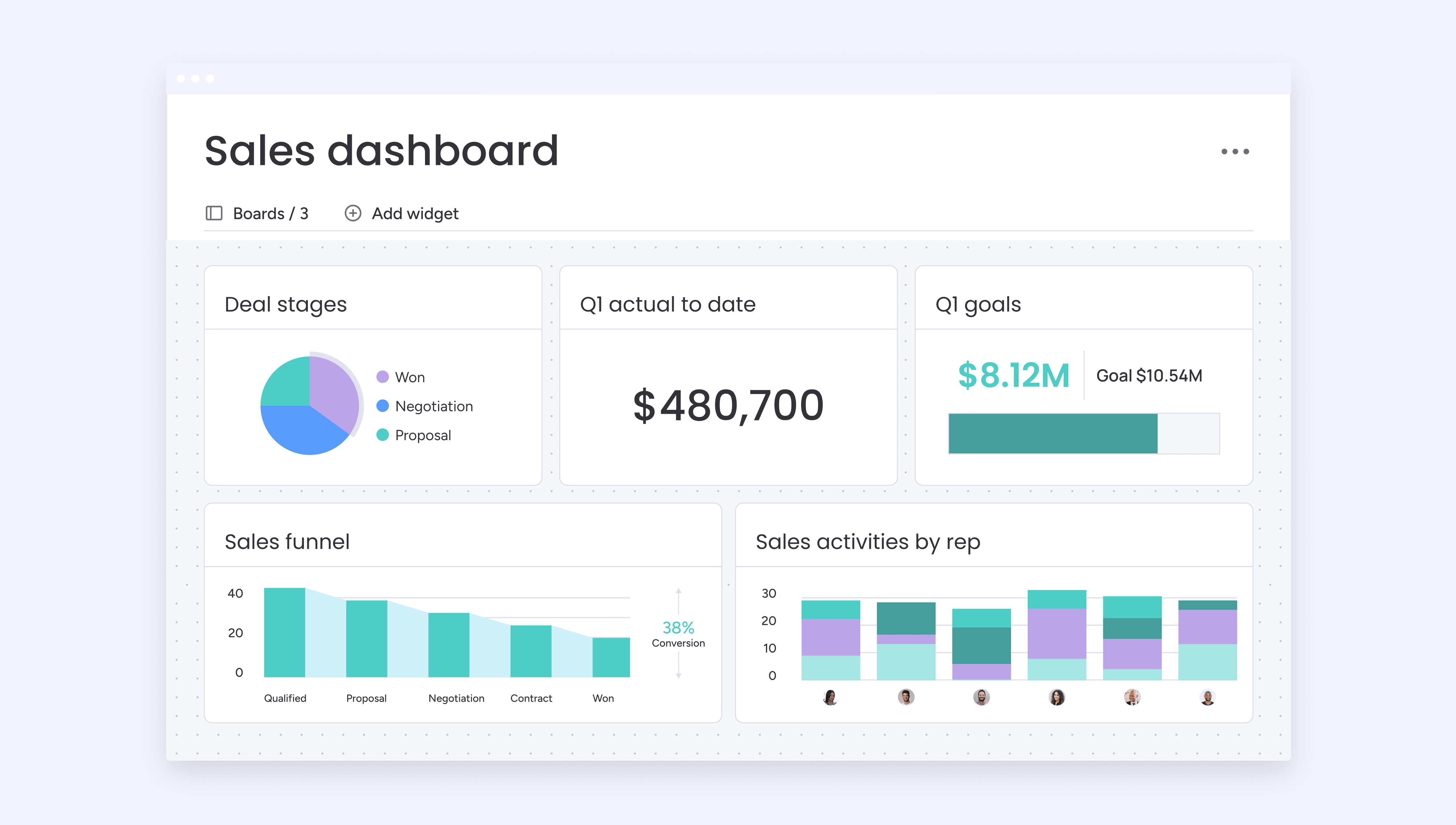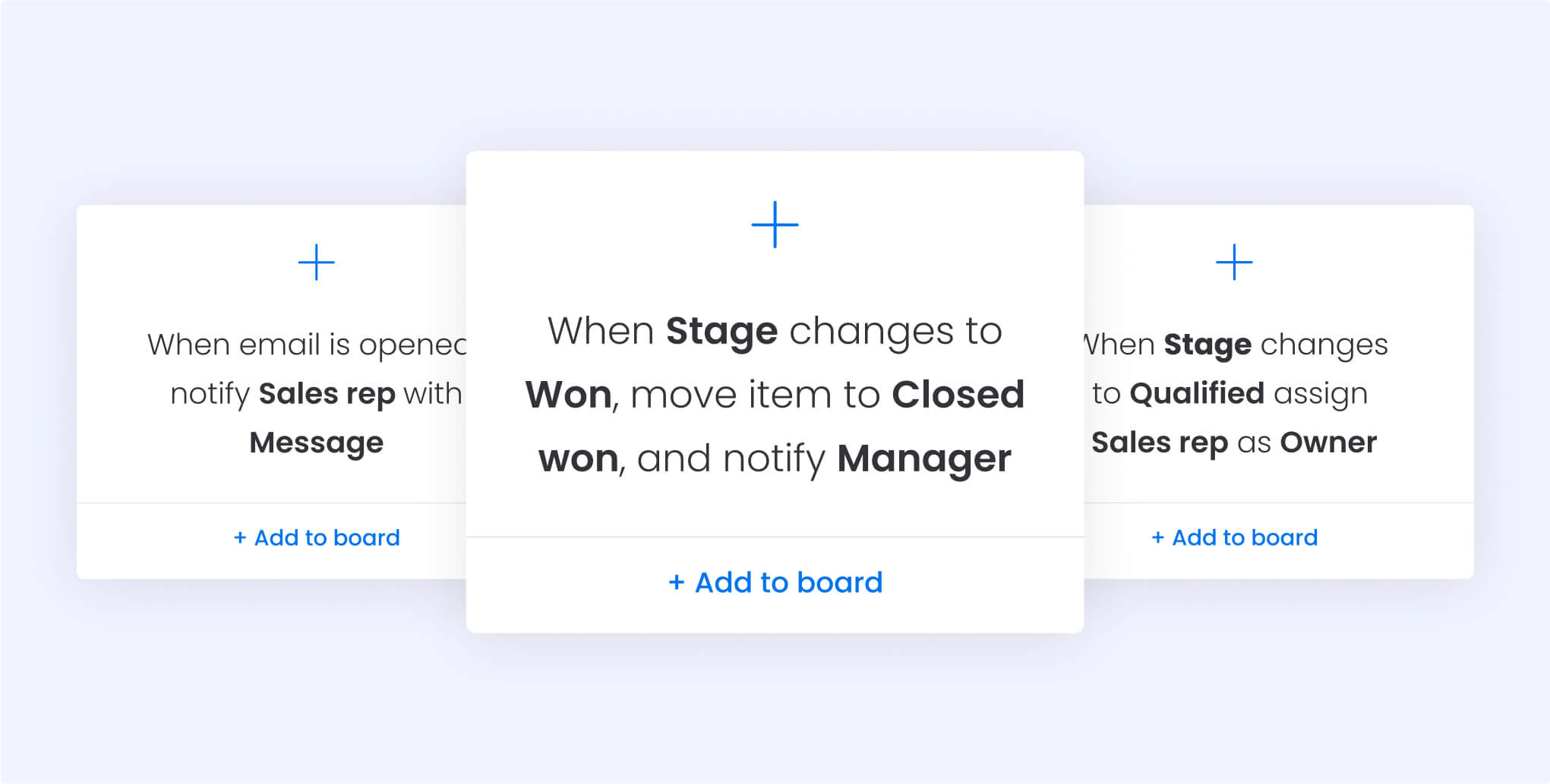Successful businesses plan ahead. They understand what revenue they’ll make this month, this quarter, and the one after that. They know how to appropriately deploy resources to sales, marketing, and customer service teams, ensuring every potential lead and customer has a positive experience of their brand to keep the money rolling in. And they achieve all this by managing their pipeline.
In this article, we’ll define pipeline management, give you some best practices for keeping up with it, and introduce how monday CRM makes pipeline management a cinch.
Try monday CRMWhat is a sales pipeline?
A sales pipeline displays potential customers’ journeys from initial contact to closing and even post-sales. If organized well, it closely tracks all sales opportunities and brings method to the madness of the sales landscape. The benefits of defining your sales pipeline include:
- Providing a visual representation: Sales professionals can clearly see where each lead or prospect stands in the sales process. This visual aid helps them quickly understand their current position, prioritize high-potential deals, and determine their next steps to move each deal forward.
- Improving collaboration: With a clear structure, every sales team member understands their role in moving leads and prospects further down the sales funnel. They can easily complete their tasks and pass the workflow over to the next team member, ensuring no one is blocked.
- Enhancing forecasting: Understanding the number of deals at each stage and how likely they are to close helps predict future performance, resource allocation, and revenue.
What is pipeline management?
Pipeline management is the practice of overseeing, directing, and optimizing sales opportunities as they move through each stage of the cycle. This management involves analyzing, improving, and supercharging your sales processes to attract more revenue. On a practical level, this includes:
- Splitting your pipeline into segments and assessing for any bottlenecks
- Using key metrics to measure your pipeline’s performance
- Allocating resources where they’re needed most
- Regularly updating your pipeline data
- Reviewing real-time data to inform decision-making
What are the 8 stages of the sales cycle?
Properly managing your pipeline involves a sales professional or pipeline manager tracking activities that pull people through your pipeline stages. As pipeline management maps so closely to the sales cycle, let’s explore its eight stages in more detail:
1. Prospecting
Prospecting involves identifying potential customers who may be interested in your product or service. This may result from conducting market research, generating leads through social media, website sign-ups, referrals, cold emailing, or any other way to build a list of potential prospects.
2. Lead qualification
Not every prospect will be a good fit. The next step is to evaluate, or score leads based on criteria such as budget, authority, need, and timing (BANT).
3. Initial contact
Start the conversation by contacting qualified leads to introduce your product or service. Before going in with a hard sell, sales professionals often use this as a fact-finding mission to understand the potential customer’s pain points.
4. Nurturing
Nurturing their interest can be a long game, involving multiple conversations and questions. It can take time for leads to develop trust in the brand, and for sales professionals to deeply understand the problem their products or services can solve.
5. Proposal
This stage of the sales cycle is all about presenting a tailored, formal proposal that highlights how the benefits and features of your product or service are the solutions your leads have been looking for.
6. Negotiation or objection handling
If the lead has any objections, concerns, or needs to make any changes to your proposal, this happens during the negotiation stage.
7. Closing
A formal agreement or purchase order signals that the customer is won and the deal has closed. Some people consider this the final stage of the sales pipeline, handing off to the customer success team to begin onboarding.
8. Post-sales
This optional pipeline management stage ensures customer satisfaction and explores opportunities for additional sales. Post-sales is also an excellent time to send out customer feedback surveys to shape your future product and sales strategies.
Who’s responsible for pipeline management?
Taking ownership over your pipeline requires discipline and attention to detail, which is an excellent quality to have in:
- Sales reps
- Sales and account managers
- Account executives
- Team leads
When each sales rep maintains their pipeline management, their sales manager can focus their efforts elsewhere, such as objection handling, risk management, and sales enablement.
Try monday CRM5 pipeline management best practices
Managing a sales pipeline isn’t a full-time job, but it does require regular attention. Follow these best practices to get the most out of your pipeline management:
1. Always be prospecting
Prospecting may seem like a no-brainer, but busy sales reps can take their foot off the gas when their sales pipeline appears full. Following the process and keeping prospecting activity levels high is the only way to ensure your pipeline stays full, blows past sales goals, and sets new records.
2. Make follow-up a routine practice
The days of one-call closes are practically over. According to Databox, the average sales cycle is 2.1 months long, extending to 2.5 months for B2B SaaS companies. You’re competing against a lot of noise out there—busy prospects are constantly bombarded with sales calls, emails, DMs, and door-to-door salespeople all vying for attention. Following up regularly and providing value is the only way through the noise.
Slipping seamlessly into your pipeline management, software like monday CRM can automate parts of the process by reminding you to follow up at certain intervals.
3. Focus on a few critical pipeline metrics
The number of key performance indicators (KPIs) your company could track is staggering. There are hundreds if not thousands of possible metric combinations that might improve your bottom line. What matters most is picking metrics your reps, leaders, and stakeholders understand and that align with your company’s overall strategy.
Some common metrics to consider include:
- Average sales velocity: How quickly leads move through your pipeline.
- Average deal size: Total revenue over a set period divided by the quantity of closed-won opportunities.
- Pipeline total value: The combined value of all opportunities at each sales cycle stage.
- Win rate: The percentage of prospects that convert to customers divided by all deals in the pipeline for that period.
- Lead response time: How long it takes to follow up on a lead.
4. Automate repetitive workflows
German economist E.F. Schumacher once said, “Any intelligent fool can make things bigger, more complex, and more violent. It takes a touch of genius—and a lot of courage to move in the opposite direction.”
Simple is better. You hired your sales reps to sell, not to do admin work, which is where sales automation comes in. For example, you might use automation to notify a sales team member once a prospect’s lead score reaches a certain threshold.
5. Regularly clean up your pipeline
Your sales pipeline can decay if you don’t maintain it. Imagine that a sales proposal was presented to a lead for $8,000 last year, but they haven’t picked up the phone or engaged with any emails since. You may assume the opportunity has faded. This potential customer has lost interest, shifted priorities, or purchased already. If you leave the opportunity in your pipeline month over month, you’ll have a falsely inflated sales forecast.
Effective pipeline management requires removing them from your sales opportunity list and setting a follow-up for months down the line.
Achieve superior pipeline management with monday CRM
Effective pipeline management is about creating a repeatable process that produces consistent results for your sales team. Robust pipeline management software is a must here, enabling you to visualize every stage in your process and proactively nurture relevant opportunities toward the finish line.
monday CRM is a purpose-built, industry-specific tool built on top of the monday.com Work OS. It provides deep and comprehensive workflows for sales and customer-facing professionals, using some of the following features to organize your sales pipelines with precision.
Built-in entity boards
In comparison to other customer relationship management platforms, monday CRM excels by offering its own pre-made entity boards. Every time a deal is closed, or a proposal is sent, your connected entity boards auto-adjust the corresponding dashboards and reports to reflect the changes.

Automation
monday CRM enables you to create automations based on specific triggers and conditions that move opportunities to different groups or assign them to different team members.
By integrating with 72+ other tools in your tech stack, it’s easy to strip repetitive tasks from your list and set them running on autopilot in the background. For example, you might automate monday CRM to log interactions, such as when a lead opens a message sent from your Gmail account.

Visibility
monday CRM allows you to manage your entire sales pipeline from start to finish. And with that promise comes a ton of visibility. Choose from Funnel charts which allow you to see pipeline conversion rates at different stages in the funnel, or a Deal Stages widget which delivers a 360-degree view of your pipeline opportunities. With 27+ dashboard views, 36+ columns, and 25+ widgets, you can set up your software to provide the exact intel you need to manage your pipeline.
Ready to get your pipeline in order? Take a free monday CRM trial today.
Try monday CRMFAQs
Why is pipeline management so important?
Pipeline management helps the team monitor several sales performance metrics, from team performance to lead qualification. It gives you a reference point to identify who and which sales process stage is successful or holding your business back.
What does pipeline mean in business?
A pipeline describes a series of distinct stages leading to a long-term goal. For sales pipelines, sometimes called sales funnels, this means visualizing the potential buyer journey from prospect to new customer. This pipeline can be horizontal or vertical, according to your preferences.
Is pipeline management a skill?
Yes, pipeline management is considered a skill as it requires specific techniques and strategies to manage and optimize the sales process effectively. It involves analyzing data, setting goals and KPIs, communicating with team members, and making strategic decisions to drive results. A pipeline manager or sales leader may take charge of this job.
 Get started
Get started 
